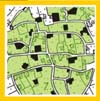
Technique:INTEGRATION OF TOWN AND COUNTRYSIDE
Project:Rescuing the Habitable Function of San Salvador’s Historic Centre
Site:San Salvador, El Salvador
Location

Click the globe to see the technique on Google Earth
|
Continent: South America
Country: El Salvador
Site: San Salvador
Coordinates:
Lat.:
13.69294
Long.:
-89.218191 |
Brief introduction
San Salvador’s historic centre has recovered its strong pulse. In a scenario in which retail and transport were gaining ground over the residential function and the few neighbours were languishing in buildings in poor condition, the Mutual Aid Residence Cooperatives decided to do battle: inception of a collaborative spirit, improvement in the quality of life, creation of urban diversity and architectural conversion.
Problems, causes and effects
The historic centre of San Salvador has experienced a process of mono-functionalism, that is, the gradual eradication of urban functions owing to the predominance of one of them, in this case the commercial one. When the Salvadorian Foundation for Development and Minimum Housing (FUNDASAL) conducted a survey on residential habits in 2003, the lid was lifted on the pressure to which the few neighbours were subjected and the low quality of the buildings was revealed. The mesones – traditional residential buildings with a communal inner courtyard – with residents had dropped by 50% in only three years.
Given the powerlessness of the authorities, 50 families joined forces to create a neighbours’ cooperative, the Mutual Aid Housing Cooperative Association of the Historic Centre of San Salvador (ACOVICHSS), with legal and technical advice from FUNDASAL. In just over a year, in 2005, a further two mesones in the historic centre became involved and established another two cooperatives.
In 2008 the tenacity of the neighbours bore fruit. The first cooperative mesón was built on a plot in the district of San Esteban, which housed 12 families from the cooperative. It was funded by the Spanish Agency for International Cooperation and Development (AECID), but it was the cooperative members who erected it with their own hands. The second one to be completed, in 2009, was “El Renacer” (The Rebirth), with a graphically descriptive name and nine families in its apartments. Three years later, the ACOVIVAMSE, in the district of San Esteban, houses 40 families.
Solutions/Project description
Conclusions
In total, more than 60 families have gone from living in dwellings in poor condition in a hostile environment to mesones built and inhabited by communities that have mutually helped each other and governed themselves to improve their situation. While their means continue to be precarious, they feel tied to the cooperatives and solidarity and responsibility govern coexistence: decisions are taken collectively (with women, incidentally, enjoying majority participation) and the arrears rate stands at 0%.
But the impact can be perceived beyond the courtyards and walls of the new mesones. The “showcase effect” was swift: around 25 housing cooperatives have been formed in El Salvador and numerous town councils have set out to rescue the residential function of their historic centres. Cooperatives are crossing borders and are being reproduced in Guatemala, Nicaragua, Honduras and Costa Rica. Precarious housing has gone from neglect to taking its place on the local and national agenda.
Images
